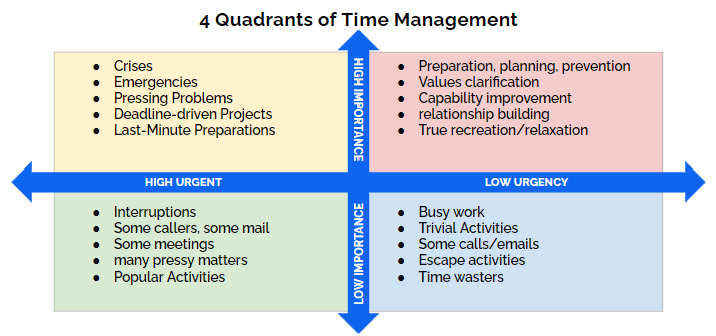Have you ever felt the time slipping from your fingers? As if there is not enough time in the day?
We all have the same 24 hours in a day, yet there are people that accomplish more in a day than others. How? Well, it all comes to good time management.
Time management is the process of organizing and planning how you divide your time between different activities to maximize productivity. Once you have learned the skill of time management, you will see a difference in how fast you check off your to-do list.
Benefits of Time Management
The ability to effectively and efficiently manage your time is a valuable skill in the workplace and one that recruiters look out for. The ability to prioritize and manage your workload is not an easy task and it takes some trial and error to get it right. When you do, it leads to increased productivity, less stress, and more freedom to achieve your goals.
Now let’s dive into the three steps to have good DAM Time Management.
Step 1: Delegate
Delegating is a valuable skill that can benefit both individuals and teams. By delegating tasks, individuals can focus on their strengths and areas of expertise, while also providing opportunities for others to develop their skills and take on more responsibility.
Effective delegation requires a number of important factors, including:
- Finding the right person, or department, for the job
- Clear instructions and communication
- Providing the necessary resources and tools
- Creating a specific structure for providing feedback and appreciation
By following these steps, leaders can ensure that their team members are equipped to succeed and that tasks are completed to the best of everyone’s abilities.
Finding the right person, or department, for the job is necessary as it ensures that the individual has the necessary skills and knowledge to complete the task successfully. Too many times individual contributors feel it is just easier to do a task themselves, rather than let the specific department handle it. Here is the problem: doing tasks that are designated for someone else to handle takes away time for you to excel at your responsibilities.
Clear communication is essential for effective delegation, as it ensures that team members understand what is expected of them and can ask any questions or raise any concerns before beginning a task and seek support for any challenges or unexpected situations that may occur during the taks.
Providing necessary resources and tools is also crucial, as it helps to set team members up for success and ensures that they have everything they need to complete the task effectively. Whether it is assuring the CRM has all the necessary information, or providing step-by-step directions, be sure to provide all the resources needed to set the team up for success.
Creating a structured feedback loop, including showing appreciation, are key components of effective delegation, as they help to motivate team members, reduce anxiety from both sides of the delegation process, and provide direction for improvement.
Overall, effective delegation requires careful planning, clear communication, and a commitment to supporting and motivating team members throughout the process. By following these steps, leaders and all team members can create a culture of success and foster a sense of teamwork and collaboration within their organization.
Step 2: Arrangement
The arrangement stage of DAM time management involves taking a proactive approach to prioritize, design, and organize your goals, schedules, and tasks in a way that enables you to make the best use of your time. During this stage, you will need to take a step back and assess your current workload, identify your most important goals and priorities, and then create a plan of action for how you will accomplish them.
This may involve setting specific, measurable goals, breaking those goals down into smaller tasks and milestones, and then creating a schedule or timeline for completing those tasks. You may also need to consider any external factors or constraints, such as deadlines, availability of resources, and other commitments that may impact your ability to effectively manage your time.
The Time Management Matrix is a popular tool designed to help you arrange tasks in order of importance and urgency enabling you to spend time on tasks that will have the biggest impact on your success. (See matrix below) Here is a simplified version of how it works: if the task falls under urgent and important, that task should move up in the priority list. If the task falls under not urgent and not important, move that task down on the priority list. Of course, even if a task is not of high priority or importance, this task still needs to be completed or delegated to the appropriate person or department.

By taking a strategic approach to time management during the arrangement stage, you can help ensure that you are focused on your most important priorities, making efficient use of your time, and minimizing distractions or time-wasting activities. This can help you achieve greater productivity by investing your time and resources on the activities that will have the biggest impact on your success. And, just as important, it can help reduce stress and burnout associated with feeling overwhelmed or overworked.
Download our Time Management Worksheet:
Step 3: Monitor
Monitoring your time while performing activities can help you identify areas where you may be wasting time or could be more efficient, allowing you to make adjustments and better manage your workload. Additionally, using microgoals and milestones, as mentioned in Step 2, can help you break down large tasks into more manageable pieces, making it easier to measure and track.
By setting small, achievable goals that can easily be measured for each task or activity, you can create a sense of progress and accomplishment that can help keep you on track and motivated. This can also help you identify potential obstacles or roadblocks early on, allowing you to change strategy as needed and stay on track to achieve your goals.
In fact, research shows that those who self-monitor are more likely to reach their goals than those who do not. We all carry a device that can help us during this stage of time management– our handy dandy cell phones. You can use the timer on your cell phone to measure lower priority tasks and a stopwatch to measure high priority tasks. Here’s how it works:
Low Priority Task Hack
For low priority tasks, setting a timer can help individuals limit the amount of time spent on these tasks and avoid getting sidetracked. This can be particularly helpful for tasks that may be less urgent or less important, but still need to be completed. By setting a specific amount of time for these tasks, individuals can better manage their time and ensure that they are not spending too much time on tasks that may not have a significant impact on their goals.
High Priority Task Hack
For high priority tasks, setting a stopwatch can be a helpful tool for measuring progress and staying focused. By tracking the amount of time spent on these tasks, individuals can better understand how much time they need to complete the task and identify any potential areas for improvement. Additionally, seeing progress in real-time can be motivating and help individuals stay on track with their goals.
Interruptions and changing priorities are a normal part of any workday, so it is important to be flexible and adaptable in your approach to time management. By regularly reassessing your goals and priorities, and adjusting your plans as needed, you can stay focused and productive even in the face of unexpected interruptions or changes in direction.
Overall, monitoring your time using microgoals and milestones and being flexible and adaptable in your approach to time management can help you stay focused, productive, and successful in managing your workload and achieving your goals.
How Can Benchmark Training Help You Succeed?
By investing in your team’s development, you can help create a culture of continuous improvement and learning, which can lead to increased productivity, better customer service, and improved employee satisfaction and retention.
Additionally, by improving your team’s skills and knowledge, you can help your company stay competitive in a rapidly changing business environment.




